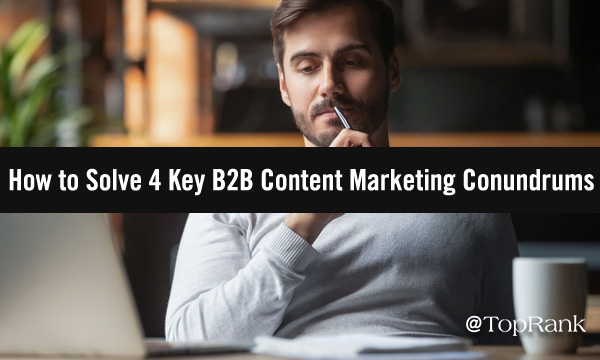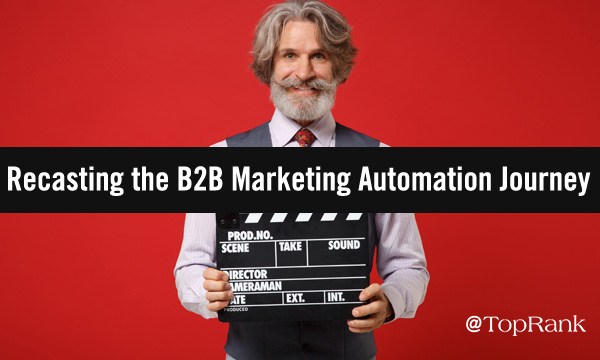

How can B2B marketers recast the marketing automation journey to meet today's challenges and be ready for those to come?
Jon Miller, chief marketing officer at Demandbase, recently presented a session at the 2021 B2B Marketing Exchange Experience virtual conference, and explored new account-based marketing best practices. Although this pandemic year at #B2BMX won’t see B2B marketers gathered in the event’s usual sunny Scottsdale, Arizona location, many new attendee opportunities were on tap virtually.
Refresh, renew, remix has been the conference’s theme this year, and to help ease the lack of physical networking, #B2BMX included a Spotify music playlist, live music performances, and even various charitable elements. Jon began by looking back at his journey starting Marketo — acquired by Adobe in 2018 for $4.75 billion — nearly 15 years ago, when marketers had a need to capture and manage online leads, a need that the company’s service met, allowing marketers to communicate and send leads to the appropriate departments. Marketo’s efforts during this era helped marketing build credibility and respect, Jon noted, as marketers became a part of their firms’ revenue engines. Today however, the world is changing and marketing automation tools aren’t necessarily keeping pace.
We’ve reached the end of the era of traditional demand generation, which has become shipwrecked, Jon explained. The General Data Protection Regulation (GDPR) and other global data protection efforts have made it more challenging for marketers to send emails in the way they were once able to, while in some instances sales teams are sending greater amounts of email now than marketers. “
Marketers lost the keys to being the sole owners of communications,” Jon said, and noted that today’s larger buying committees also present challenges when trying to hold one-on-one interactions. This is where marketing can play a larger role, he noted. Firms today are often generating more revenue after the sale in the form of recurring revenue and a focus on expansion, Jon observed. There’s a strong bias in marketing automation tools against net-new business, while at the same time increasing revenue is being generated after the sale, which led Jon to share some of the limitations of traditional lead-based approaches:
- It doesn’t make sense for marketers to be looking at leads while salespeople look at accounts
- Buyers have become harder than ever to reach, and have a greater reluctance to filling out forms than ever before
- Greater quantities of research that once took place on a business’ website are now done elsewhere, making the tools that track on-site activities less effective
- Buyer intent signals are hidden to traditional marketing automation software, as the digital body language has moved to third-party sites
Jon also pointed out a number of other factors that have contributed to the shipwreck that traditional demand generation has found itself in, including:
- Missed pipeline goals
- Poor alignment between marketing and sales
- Obstacles to moving upmarket
- Sluggish expansion revenue
- Inefficient complexity and wasted time
Jon then explored how B2B marketers can move from this to a dynamic process where sales and marketing work as a team, each able to access relevant information from today’s more complex buyer journey. Leaving behind the traditional marketing technology built more than a decade ago is a key step, Jon noted. Jon then asked, “So what’s next, and how do we move forward?”
Modern Sales & Marketing Alignment: Find, Engage, and Close
1 — Finding The Most Valuable Accounts
The first step in adapting to the new realities of B2B marketing and sales alignment is to
find, by focusing efforts on locating the most valuable accounts, Jon explained. “
When it comes to finding target accounts, one size does not fit all,” Jon said, and marketers should do deep-dive one-to-one level account research, using highly-customized programs for each major strategic account — a process that is often a significant investment. Another segment, one-to-few, focuses on moderately personalized deep cluster research — using micro-clusters of accounts focused on similar business issues, Jon explained. An additional level with a broader scope is the one-to-many level, which is where many account-based programs exist, with a basic level of light personalization and much less investment per account, Jon noted. The one-to-many level often benefits from greater use of technology such as intent data, making it more scalable. The broadest category of all is the targeted demand generation segment, Jon explained, usually using traditional marketing tactics to go after specific accounts. When considering which of these four levels to use for your business, the key is to
find which one is truly the best fit for your selling style, Jon noted, and encouraged organizations to get creative and use custom level names such as tiers. Jon urged businesses to find their entitlements — the contract of how marketing and sales agree to treat each account and what each department will do — in order to learn how many accounts your organization can handle. Entitlements can be evergreen — offering continuing qualities that persist — or of the triggered and in-market variety, such as when an account is in an active buying process or has a new corporate executive, Jon explained. Businesses often place greater focus on these triggered entitlements. The process of finding your firm’s entitlements is a great way to bring sales and marketing teams together, Jon noted. Once the number of entitlements have been determined and you know how many accounts you can have, you can begin to use science and technology to focus on the key ones, and Jon shared the F.I.R.E. acronym:
- (F)it — how close is this account to your ideal customer profile
- (I)ntent — the interest accounts have in your products or those of your competitors
- (R)elationship — is this an account your salespeople are already talking with
- (E)ngagement — is this account coming to you and spending time on your website or attending your firm’s events
Combined, these form what Jon refers to as
pipeline prediction, used to determine which accounts should be moved up to the next level, and find the accounts that really matter. [bctt tweet="“When it comes to finding target accounts, one size does not fit all.” — Jon Miller @jonmiller" username="toprank"]
2 — Engaging Identified Accounts
The second step in utilizing the new realities of B2B marketing and sales alignment is
engagement, where the identified accounts are engaged, aligning your interactions with the buyer’s journey, Jon explained. Jon noted how in the past he has likened the use of ABM processes to fishing with spears for the big fish, while demand generation is more like fishing with a net. An overlooked issue when using those ABM spears, however, is that “
Getting poked by a spear doesn’t feel very good,” Jon said. Smart ABM processes can overcome the reluctance and pain traditional methods often generate, by understanding where a buyer is on their journey and aligning all interactions appropriately, Jon explained. Jon then shared Gartner’s “
Six Buying Jobs,” that all accounts ought to go through, to ensure that everyone on the buying team is working together.
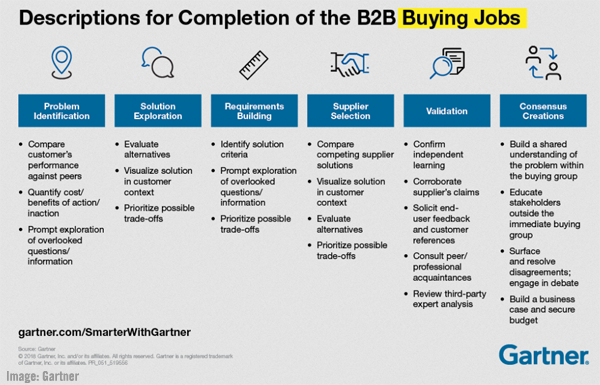
It’s important to have content that’s aligned to each of these six buying jobs, Jon noted, and also suggested keeping in mind that buyers don’t travel on their journey in an orderly or linear fashion, instead bouncing around in typically unpredictable and even chaotic directions. In the non-linear buying process Jon suggested using a football field’s yard line grid to determine how close to the scoring or buying point a buyer is, and considering the path that a football takes as it moves in many directions on the playing field. The buyer’s yard-lines tell us where in the journey they are, as well as the likelihood of an imminent score or purchase, Jon noted, and they can also inform our decisions as to which plays or plan of business approach we should execute.
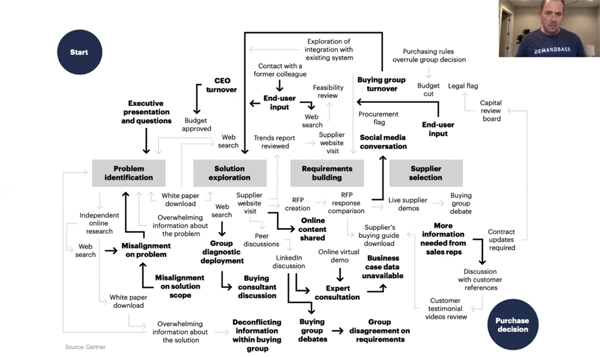
Businesses should create their own buyer journey definitions, and Jon shared how Demandbase organizes theirs, with:
- Qualified — ideal customer profiles
- Awareness — showing awareness and intent for our category, especially on third-party sites
- Engaged — engaging with our website, events, and programs
- MQA — Marketing Qualified Account, using intent data and the pipeline prediction process to know whether an account is in-market or in a buying cycle
- Opportunity
- Customer — A closed/won opportunity
- Post-Sale — Adoption and expansion
At this point sales and marketing teams can align their interactions to the buyer’s journey, such as
building brand trust early in the journey in the “qualified” stage, to
thought leadership in the middle stages, all the way through enhancing the post-sale experience by finding expansion opportunities, Jon noted. The MQA stage is especially well-suited for utilizing a multi-channel approach, Jon suggested, from customer relationship management (CRM) and marketing automation to ad platforms, direct mail, account-based chat, and sales engagement, among several other channel opportunities. [bctt tweet="“The explosion of digital noise means that traditional marketing channels like ads are becoming less and less effective. What marketers need to think about is, how do I orchestrate multiple channels together?” — Jon Miller @jonmiller" username="toprank"]
3 — Closing As An Orchestrated Team
The third major strategy Jon shared during his insightful and energetic #B2BMX presentation was the closing element, with a focus on working as an orchestrated team and not merely the outdated hand-off of the account baton. How can businesses have sales and marketing work together in a new way? With today’s B2B buyer journey being so complicated, the baton hand-off approach doesn’t work, Jon observed, and encouraged a team approach more like the way a soccer team functions, passing customer engagement back and forth as needed, in a coordinated way. Comprised of three levels, the type of marketing and sales alignment that Jon spoke about can be broken down into:
- Aligning data — Assuring that sales and marketing teams are looking at the same data
- Sharing insights — Teams proactively alerting each other about relevant insights
- Coordinating interactions — Working together as an orchestrated team
[bctt tweet="Marketers need to break free over the next 10 years by radically changing how they work with sales, stopping the baton hand-off model and moving much more of an integrated team. ” — Jon Miller @jonmiller" username="toprank"] Jon then shared a favorite tip, which he called a secret weapon for marketing and sales alignment —
account standups. In these deceivingly simple account standup events,
every few weeks the marketing and sales account teams meet without any executives or managers present, and talk about what’s happening and strategize. Jon explained that account standups are one of the best and simplest ways to move ahead with quality coordinated ABM strategies and tactics. Jon then shared the
TOPO account-based technology stack, with its intent, account, and contact data all the way through to the processes of execution, measurement, infrastructure, and application workflow.

Jon shared how the execution stage features many channels, which typically won’t all be used but each serve a specific purpose, and the overall chart is helpful for determining where to focus time and energy, he explained. Jon concluded his session by reiterating that account automation tools were built for a different time than the more complicated B2B buying landscape that we face today, which is much better met using the orchestrated methods he dug into during his presentation. It’s time to start thinking about new processes and technologies, especially those in the F.I.R.E. strategy, and to define your business’ entitlements and tiers, Jon urged. Learn more from Jon by watching our
Break Free B2B Marketing video interview, and be sure to connect with him on
Twitter and
LinkedIn. Creating award-winning B2B marketing takes considerable time and effort, which is why many firms choose to work with a top digital marketing agency such as TopRank Marketing.
Contact us today and let us know how we can help, as we’ve done for businesses ranging from LinkedIn, Dell and 3M to Adobe, Oracle, monday.com and others.
The post Find, Engage and Close: Demandbase’s Jon Miller on Recasting the B2B Marketing Automation Journey #B2BMX appeared first on B2B Marketing Blog - TopRank®.

from B2B Marketing Blog – TopRank® https://ift.tt/3dO0Ptk
via
IFTTT









 In this episode of the
In this episode of the  In this episode of the
In this episode of the 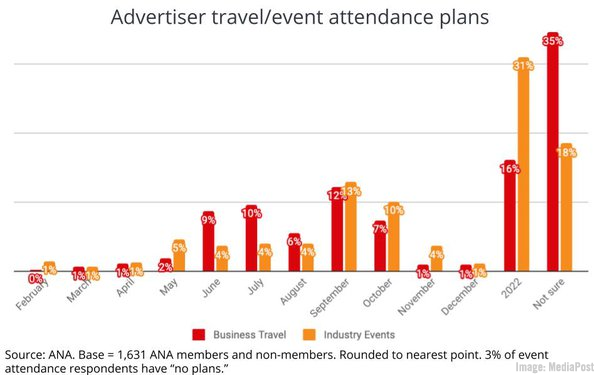
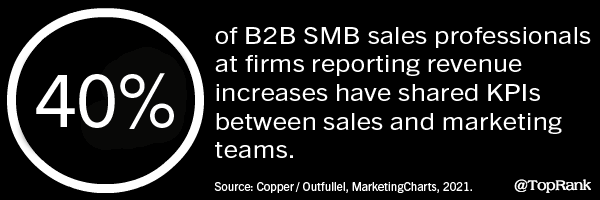 How IT Buyers' Researching Behaviors Changed in 2020 More than 54 percent of information technology buyers spent more time researching solutions during the second half of 2020, with some 24 percent reporting research time staying flat — two of several findings of interest to digital marketers in recently-released survey data.
How IT Buyers' Researching Behaviors Changed in 2020 More than 54 percent of information technology buyers spent more time researching solutions during the second half of 2020, with some 24 percent reporting research time staying flat — two of several findings of interest to digital marketers in recently-released survey data.  A lighthearted look at “finding your brand purpose” by Marketoonist Tom Fishburne —
A lighthearted look at “finding your brand purpose” by Marketoonist Tom Fishburne — 
 It’s important to have content that’s aligned to each of these six buying jobs, Jon noted, and also suggested keeping in mind that buyers don’t travel on their journey in an orderly or linear fashion, instead bouncing around in typically unpredictable and even chaotic directions. In the non-linear buying process Jon suggested using a football field’s yard line grid to determine how close to the scoring or buying point a buyer is, and considering the path that a football takes as it moves in many directions on the playing field. The buyer’s yard-lines tell us where in the journey they are, as well as the likelihood of an imminent score or purchase, Jon noted, and they can also inform our decisions as to which plays or plan of business approach we should execute.
It’s important to have content that’s aligned to each of these six buying jobs, Jon noted, and also suggested keeping in mind that buyers don’t travel on their journey in an orderly or linear fashion, instead bouncing around in typically unpredictable and even chaotic directions. In the non-linear buying process Jon suggested using a football field’s yard line grid to determine how close to the scoring or buying point a buyer is, and considering the path that a football takes as it moves in many directions on the playing field. The buyer’s yard-lines tell us where in the journey they are, as well as the likelihood of an imminent score or purchase, Jon noted, and they can also inform our decisions as to which plays or plan of business approach we should execute.  Businesses should create their own buyer journey definitions, and Jon shared how Demandbase organizes theirs, with:
Businesses should create their own buyer journey definitions, and Jon shared how Demandbase organizes theirs, with:
 Jon shared how the execution stage features many channels, which typically won’t all be used but each serve a specific purpose, and the overall chart is helpful for determining where to focus time and energy, he explained. Jon concluded his session by reiterating that account automation tools were built for a different time than the more complicated B2B buying landscape that we face today, which is much better met using the orchestrated methods he dug into during his presentation. It’s time to start thinking about new processes and technologies, especially those in the F.I.R.E. strategy, and to define your business’ entitlements and tiers, Jon urged. Learn more from Jon by watching our
Jon shared how the execution stage features many channels, which typically won’t all be used but each serve a specific purpose, and the overall chart is helpful for determining where to focus time and energy, he explained. Jon concluded his session by reiterating that account automation tools were built for a different time than the more complicated B2B buying landscape that we face today, which is much better met using the orchestrated methods he dug into during his presentation. It’s time to start thinking about new processes and technologies, especially those in the F.I.R.E. strategy, and to define your business’ entitlements and tiers, Jon urged. Learn more from Jon by watching our 
 Beverly Jackson
Beverly Jackson  Bozoma Saint John
Bozoma Saint John  Dr. Candace Steele Flippin
Dr. Candace Steele Flippin  Dara Treseder
Dara Treseder  Deirdre Findlay
Deirdre Findlay  Gail Moody-Byrd
Gail Moody-Byrd  Jeanine Liburd
Jeanine Liburd  Leah Frazier
Leah Frazier  Lisa Maxwell
Lisa Maxwell  Tyrona (Ty) Heath
Tyrona (Ty) Heath 
 The Agency Spark Podcast, hosted by Sara Nay, is a collection of interviews from thought leaders in the marketing consultancy and agency space. Each episode is designed to spark ideas you can put into practice for your agency today.
The Agency Spark Podcast, hosted by Sara Nay, is a collection of interviews from thought leaders in the marketing consultancy and agency space. Each episode is designed to spark ideas you can put into practice for your agency today.
 The emotional transaction is the glue that binds customers to a brand’s message, making them feel connected at the most human level, Miri explained, and mentioned LinkedIn’s January 2020 report which found that empathy was the platform's top 2019 theme — one that offers strength to both brands and customers. “Brands want to transact with people who are showing high levels of empathy,” Miri noted. [bctt tweet="“Brands want to transact with people who are showing high levels of empathy.” — Miri Rodriguez @MiriRod #B2BMX" username="toprank"] Since the pandemic began, empathy has only increased in its importance for B2B brands, and increasingly employees want to work for brands that include high levels of empathy, she noted. How can you begin leading with empathy? Miri mentioned the oft-used Bill Gates “content is king” adage as a jumping off point for all that exists beyond content for today’s B2B marketers seeking to infuse greater empathy in their brand storytelling efforts. One key is finding a universal truth, especially when it’s an actionable emotion that your brand lives by, and Miri suggested that these types of truths often derive from a brand’s mission statement.
The emotional transaction is the glue that binds customers to a brand’s message, making them feel connected at the most human level, Miri explained, and mentioned LinkedIn’s January 2020 report which found that empathy was the platform's top 2019 theme — one that offers strength to both brands and customers. “Brands want to transact with people who are showing high levels of empathy,” Miri noted. [bctt tweet="“Brands want to transact with people who are showing high levels of empathy.” — Miri Rodriguez @MiriRod #B2BMX" username="toprank"] Since the pandemic began, empathy has only increased in its importance for B2B brands, and increasingly employees want to work for brands that include high levels of empathy, she noted. How can you begin leading with empathy? Miri mentioned the oft-used Bill Gates “content is king” adage as a jumping off point for all that exists beyond content for today’s B2B marketers seeking to infuse greater empathy in their brand storytelling efforts. One key is finding a universal truth, especially when it’s an actionable emotion that your brand lives by, and Miri suggested that these types of truths often derive from a brand’s mission statement.
